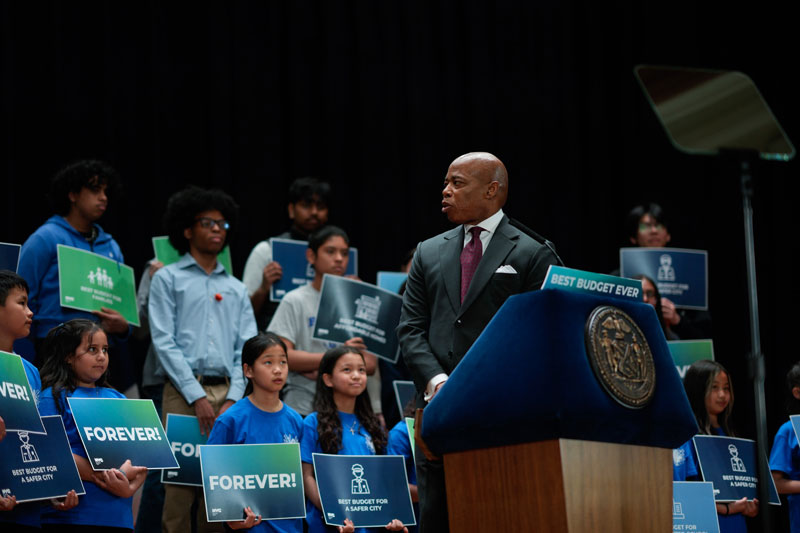NEWYORK: New York City Mayor Eric Adams released the “best budget ever” — the balanced, $115.1 billion fiscal year (FY) 2026 executive budget that makes new investment in a safer, more affordable city that is the best place to raise a family.
Through strong fiscal management, the Adams administration has, once again, set the table for strategic investments that protect funding for critical services, invests in public safety by allocating funding for key criminal justice reform programs, and put the New York city police department on track to reach a uniformed headcount of up to 35,000 officers by the fall of 2026. Additionally, this budget increases affordability, cleans city streets and parks, build more affordable housing, fulfills massive generational projects, and expands educational opportunities like early childhood education and universal after-school for New York City’s children and their families, among other initiatives, all while maintaining record-high reserves and ensuring a strong fiscal future for the City of New York.
“Today, I am proud to present our Fiscal Year 2026 Executive Budget: Our ‘Best Budget Ever,’” said Mayor Adams.
“This budget is a testament to our commitment to making New York City safer, more affordable, and the best place to raise a family. From prioritizing access to child care and launching ‘After-School for All’ to investing in permanent funding for libraries, CUNY, and our world-class institutions that make New York City what it is, to tackling quality-of-life issues and making our streets safer, the $1.4 billion we’re investing to protect and lift up critical programs will make lives better for families across all five boroughs. We are doing all of this while maintaining record-high reserves to help us face anything that comes our way. And, with the city’s largest 10-year capital plan at $173 billion, we are delivering on infrastructure improvements and transformative generational projects that were talked about for decades but never achieved. This is the budget my mom needed, that my family needed, and, with it, we’re saying to working families: your city has your back.”
The FY 2026 Executive Budget remains balanced at $115.1 billion, with gaps of $4.6 billion in FY27, $5.8 billion in FY28, and $5.7 billion in FY29.
The city’s strong economy — notably in job creation and tourism — reflects the Adams administration’s strong fiscal management and laser-focus on policies that keep New York City a safe and clean place to live, work, and raise a family. Tax revenue is expected to increase by nearly 8 percent in FY 2025, driven by growth in income and business taxes, though, as the economy slows, growth is forecast to decline to around 1 percent in FY 2026. This results in an upward revision over the FY 2026 Preliminary Budget of $1.7 billion in FY 2025 and $1 billion in FY 2026, and puts the city forecast on-par with fiscal monitors and the New York City Council.
This baseline forecast is predicated on economic conditions, as well as federal fiscal and trade policy known prior to April 2025. The unprecedented and unpredictable federal trade policy recently announced in early April and the subsequent impact on financial markets poses a potential impact to the city’s economy as well as its tax base. The outlook may be updated in the upcoming Adopted Budget, if necessary.
The Adams administration remains focused on saving taxpayer dollars. Total citywide savings in this plan are $1.9 billion over FY 2025 and FY 2026, and were achieved without a PEG program, service cuts, layoffs, or raising taxes. This includes asylum seeker savings of $298 million in FY 2025 and$1.2 billion in FY 2026, with $1 billion of the savings achieved in FY 2026 used to offset $1 billion in assistance the city assumed the state would, but did not, provide in FY 2026.
Maintaining budget reserves as a safeguard against the unexpected is a critical part of the Adams administration’s strong financial management strategy. The FY 2026 Executive Budget maintains a record level $8.5 billion in reserves, including $1.2 billion in the General Reserve, $5 billion in the Retiree Health Benefits Trust Fund, $250 million in the Capital Stabilization Reserve, and a record level of $2 billion in the Rainy-Day Fund.
Last April, under the leadership of Mayor Adams and New York City Office of Management and Budget Director Jacques Jiha, Ph.D., New York city became the first big city in the United States to implement climate budgeting, a system that integrates climate targets and considerations into the budget process to support achieving the city’s goals of net-zero greenhouse gas emissions and resiliency to climate threats.
In this Executive Budget, the Adams administration will be releasing the second annual Climate Budgeting publication, which showcases the city’s commitment to funding climate action, including nearly $8 billion in capital funding for decarbonization and almost $13 billion for flooding and extreme heat resiliency. Climate budgeting is an ongoing and evolving process that will continue to demonstrate how New York City’s leadership will advance sustainability and resiliency in a cost-effective way.
In the FY 2026 preliminary budget, Mayor Adams announced the city’s largest 10-year capital plan at $170 billion. Now, the city is beating that record, to increase the capital plan even further, to a record $173.4 billion over the next decade.
This will improve the city’s infrastructure, including its roads, bridges, schools, water and sewer facilities, libraries, and transportation systems in neighborhoods across the five boroughs. As the largest 10-Year Capital Plan in city history, it includes $33.3 billion for the New York City Department of Environmental Protection; $32 billion for transportation and $400 million for mass transit; $24.7 billion for affordable housing.; $23.8 billion for New York City Public Schools; $16.1 billion for the New York City Department of Correction, courts, and the NYPD; $10.4 billion for New York City Department of Parks and Recreation; $3.2 billion for DSNY; $29.5 billion for other city services, including $6.6 billion for economic development and $3.1 billion for cultural institutions and libraries.
New investments funded within the 10-Year Capital Plan include: completing the funding for the “future of fifth” project that will transform Fifth Ave between Bryant Park and Central Park into a pedestrian-focused boulevard($250 million); addressing maintenance and renovations across all three library systems, including nearly $51 million designated for heating, ventilation and air-conditioning systems and $50 million towards a comprehensive renovation of the landmarked Seward Park Library branch ($169.1 million); adding matching funds to support reconstruction and revitalization at the Brooklyn Marine Terminal to support the “Harbor of the Future” ($109.3 million); adding resources for the reconstruction of the historic Tony Dapolito Recreation Center to fully fund the project, including a fully accessible pool, a pool house building, a new indoor recreation center, and preservation of the iconic Keith Haring mural ($51.8 million); replacing the pedestrian bridge at East 25th Street over the FDR Drive as part of the Science Park and Research Campus Kips Bay project that will create a state-of-the-art life sciences, health care, and public health hub ($42 million); funding to continue investments near the Hunts Point Market by improving and expanding public waterfront access next to the Market ($28.3 million).
The FY 2026 Executive Budget builds on the administration’s $114.5 billion FY 2026 preliminary budget which deepened the administration’s commitment to strong fiscal management, achieved savings and reduced asylum seeker costs, invested in critical programs and services, and made the city safer, more affordable, and more livable for working-class New Yorkers. These achievements were also made possible due to the strength of the national and local economies.



